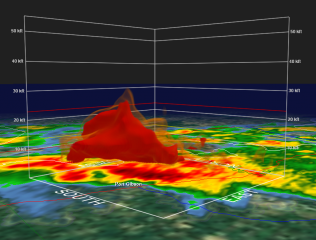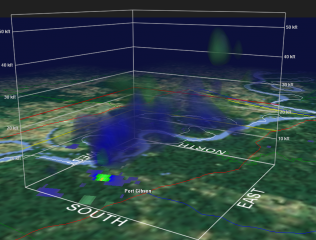The death toll from yesterday’s tornadoes in the South presently stands at 231,* and it continues to climb. In the battered town of Tuscaloosa, Alabama, 36 people are dead; in Birmingham, at least 30 more.** From
Mississippi to as far north as upstate New York, the worst tornado outbreak in 37 years has left communities sifting through a battleground of leveled buildings, crumpled automobiles, downed power lines, tortured trees, and a horrifying number of casualties. This has been no mere tornado outbreak; it has been a tornado nightmare.“You’re talking about whole neighborhoods of housing just completely gone,” said Birmingham Mayor William Bell in an NPR interview. “Churches, gone. Businesses, gone. I’m not talking about just roofs being blown off, but just completely gone.”**
I knew that a dangerous weather event was brewing in the South yesterday. But with my mother undergoing a knee replacement, I spent most of the day at Blodgett Hospital here in Grand Rapids, Michigan. I knew nothing of what was transpiring down in Mississippi, Tennessee, and the epicenter of the outbreak, Alabama, until later in the evening, when I finally left the hospital, fired up my laptop, and got my first look at the radar.
There it was, spread out before me: a blitzkrieg of intense supercells swarming across Alabama and Tennesse, attended by so many tornado reports that they obscured parts of the map. My heart dropped into my gut. I didn’t need any news reports to tell me that something awful was happening and people were getting killed.
Immediately I thought of my long-time friend and storm chasing partner, Bill Oosterbaan. He was down there somewhere in Alabama. I had no question that he’d seen tornadoes, but was he safe? I couldn’t reach him at first on his cell phone, but eventually we connected and Bill shared his story. He had been about a quarter-mile behind a tornado that hit Huntsville and gotten rained on by debris. It sounded bad, but Bill was okay, had witnessed five tornadoes, and had gotten video footage.
After talking with Bill, I began searching for news on Facebook and the Internet. The first video I saw was Chris England’s footage of the Tuscaloosa tornado as it chewed through the city. “Andover!” I thought. “It looks like the Andover tornado.” (An F5 monster that struck Andover, Kansas, on April 26, 1991.) More YouTube videos followed: Mind-boggling views of the Tuscaloosa storm. TWC footage of a violent, mile-wide wedge moving through Birmingham. An intense tornado striking Cullman. It was horrible. The storms were ongoing even as I watched, and it dawned on me that, overworked as the word “epic” has become, here was a situation where it applied.
I am appalled by the news and deeply saddened. As good as today’s weather warning system is, nevertheless the death toll is mind-numbing. I frankly expected a few score fatalities, and that in itself would have been too many. Lives are lives. But this many lives…it is just sickening. Were it not for the unswerving vigilance of the Storm Prediction Center and the National Weather Service; and were it not for today’s NEXRAD system that blankets the nation with Doppler radar to provide coverage that far outstrips what existed during the historic 1974 Super Outbreak and 1965 Palm Sunday Outbreak; were it not for these things, then the death toll from yesterday would have been apocalyptic. As it stands, it is horrifying, and the number continues to grow.
My writing on this event is finished for now. There is simply too much to say and too much news that is yet breaking, along with countless hearts. The story has just begun, and more can be told only as it becomes known. My thoughts and prayers go out, with those of countless other storm chasers, to the survivors of this terrible disaster.
————————————
* From CNN’s live blog.
** From NPR’s news blog, “The Two-Way.”




